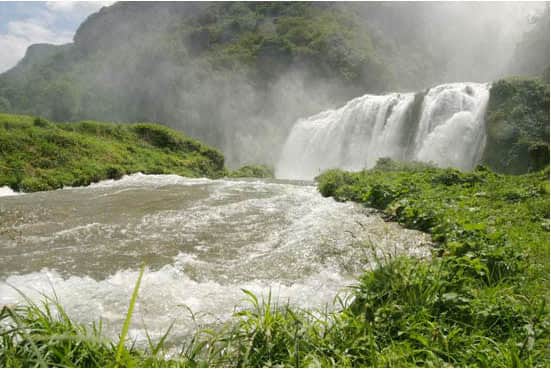Water Fall of the "Marmore"

The Water Fall of the "Marmore"
is an artificial fall that goes up again to the Roman age, the purposes that
have the techniques of control of the waters are three and of fundamental importance:
first of all to make cultivable and habitable new earths to free her from the
stagnant waters, to irrigate the fields and water for the population of the
cities.
The creation of the Fall of the Marmores happened for work of the Roman consul
Curio Dentato in the 271 b.C. with the goal to reclaim the plain one of Rieti
and to free therefore the valley Reatina from the swamp, that was caused by
the river Velino; did therefore to dig in the rock a channel, (cable Curiano),
doing so to fall in the underlying river Nera the river Velino.
To free the valley Reatina from the swamp caused by the waters of the river
Velino, the consul Curio Dentato makes to dig in the rock a channel, denominated
cable Curiano, making to fall in the underlying river Black the waters of the
Velino, so the valley Reatina, even if in the plain Reatina some lakes remain
in how much the cable Curiano doesn't succeed in containing completely the floods
of the Velino and in the brief period the Fall resolves the problem of the swamp
but it creates others of it in the territories to valley.
The Ternani in 1385 stop the
project of the Reatini, to make an alternative channel to that Curiano, the
Ternani fear the flood of own earths because of the excessive immission of waters
of the river Velino in the river Nera, project that is interrupted therefore
from the Ternani, project that however is taken back and completed by the Reatini
in 1422, realized by the architect Fioravanti on commission of Arm Fortebraccio
of Montone, after the Reatini in 1417 conquer Fortress St. Zenone, built by
the Ternani to prevent note the change of the cable Curiano, the parallel cable
built by the Reatini takes the name of cable Reatino.
After various attempts, Pope Clemente VIII entrusts the architect Giovanni Fontana
to set remedy to the problem of the swamp of the plain Reatina, proposing the
solution effected by the Romans in the III sec. b.C. and in 1601 it inaugurates
the cable Clementino, in practice, it makes to widen and to lower the fund of
the ancient cable Curiano, increasing the inclination to increase the speed
of the waters; besides it makes to build a "bridge regulator" to regulate
note the passage of water and to prevent so ruinous floods in the underlying
valley of the river Nera.
The new channel finally succeeds
in the Reatino, provoking the division of the lake Veils in more autonomous
basins (lakes of Ventina, of Canale, of Cor of the Stella and Piediluco) and
the run of the river making independent Velino. The "bridge regulator",
however, it reveals entirely not him effective, the mass of water that falls
from the Fall it hinders the outflow of the Nera and, in the periods of intense
raininess, it provokes awry the flood of the countries for different kilometers
of the Fall.
Only 1787 the architect's project
Andrea Vinci gives actual aspect to the Fall, project approved by Pope Pious
VI to realize You a diagonal cut around second leap.
In 1861 it begins the industrial future of Terni, from this moment in then the
Fall it is not tool of reclamation of the territory or regulation of the water
system anymore, but they start him to appraise the energetic possibilities.
Between 1881 and 1884 is built
to Terni the Factory of weapons and it is for favoring installation that between
1873 and 1879 the Municipality he makes promoter of the construction of the
channel Nerino.
In 1886 the Society of the Tall Ovens Foundries and Steelworkses of Terni, the
first steelworks of Italy, begins working: all of its mechanisms are fed by
the strength engine assured by 2 meters water's cubes derived by the right bank
of the cable Curiano.
